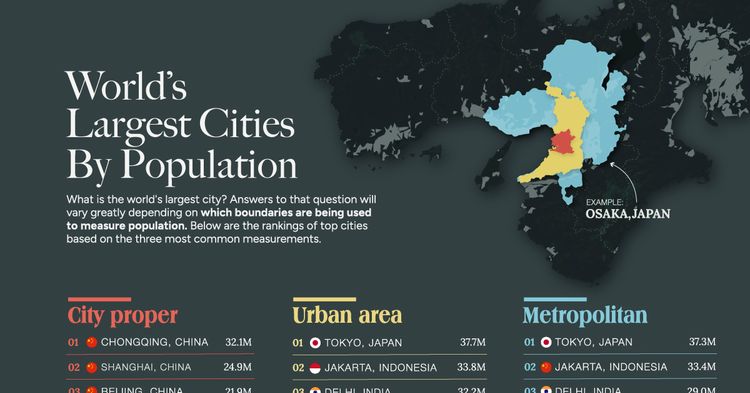Ranked: The World’s Largest Cities By Population

Top Cities By Population
In the past hundred years, there has been a significant increase in urbanization worldwide.
Currently, there is a vast number of 4.3 billion individuals residing in urban areas, constituting approximately 55% of the global population.
However, determining the world's largest city can yield diverse answers depending on the criteria applied to define city limits and calculate their populations.
The image presented above utilizes information gathered from the most recent official population counts and estimations to determine the leading cities based on three prevailing criteria.
Biggest Cities By Population
The initial measurement we use is founded on the city itself, referring to the official limits set by the administration.
As stated by the United Nations, a city proper refers to the "singular governing authority that encompasses the distinctive core of the city's history."
Chongqing, a city in China, takes the top spot in terms of this measurement. It boasts an administrative boundary that spans the same area as Austria and is home to an urban population of 32.1 million people.
The city's elevated train system is known for being the most extensive and crowded across the globe, with a remarkable number of 70 stations. Chongqing Jiangbei International Airport is recognized as one of the 50 most bustling airports worldwide. Furthermore, this city is also positioned among the top 50 global centers for scientific exploration.
The measurement shows that other cities in China are leading the ranking.
Delhi, the initial non-Chinese metropolis, has been undergoing a remarkably rapid growth in its urban landscape.
According to the United Nations, India is expected to witness a surge in its urban population, with an estimated increase of more than 400 million individuals by the year 2050. This surpasses the projected growth of around 250 million people in China and approximately 190 million in Nigeria.
Biggest Cities
This calculation largely disregards geographical borders and perceives a city as a united and continuous urbanized region.
Demographia characterizes urban regions as operating as a cohesive economic entity, interconnected through the movement of commuters and various social and economic interactions.
Based on this measure, Tokyo occupies the top position in the ranking.
The urban district contains roughly one-tenth of the Japanese population. If we take into account the larger Tokyo metropolitan area, which includes cities such as Kanagawa, Saitama, and Chiba, the overall population of Tokyo exceeds 37 million people, accounting for approximately 30% of the entire country's population.
As a result, despite having one of the most extensive railway networks globally, the trains in Tokyo are exceptionally congested, reaching a staggering 200% capacity during rush hours in the most densely populated regions. Tokyo is equally renowned for its Shibuya Crossing, considered the most bustling crossroad found anywhere on Earth.
Biggest Cities By Metro Area
Tokyo remains at the forefront when it comes to our last measurement, metropolitan region.
This metric is akin to city region, yet typically determined by authorized institutions, whether for statistical objectives or governing.
In the US, this is represented by metropolitan statistical areas (MSAs), for instance, the combination of cities like Chicago-Naperville-Elgin or Phoenix-Mesa-Chandler.
With the continuous growth of the global urban population, upcoming cities, particularly in Africa and Asia, are anticipated to compete for the title of being the "biggest" in the near future.
According to the United Nations, it is estimated that by 2050, approximately 68% of the global population will reside in cities or urban regions.









































